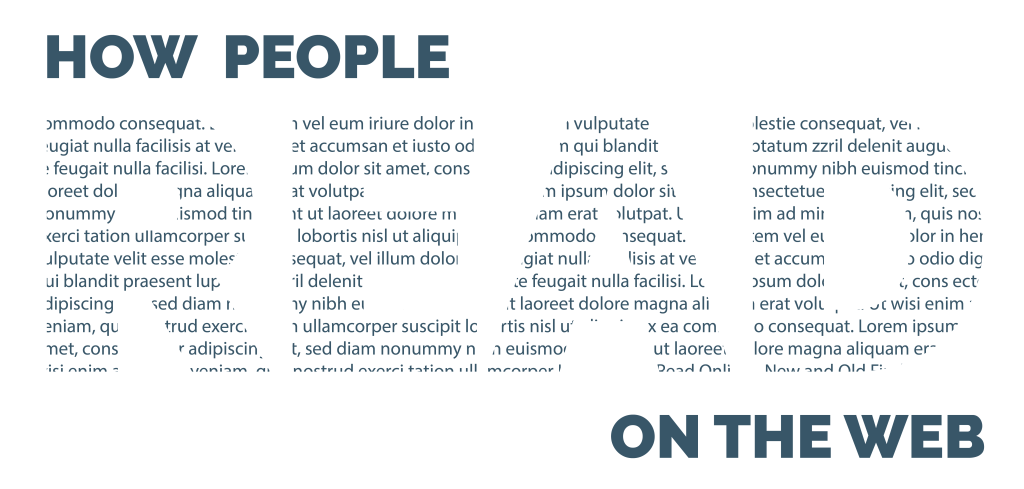
The internet is a beautiful place that has a wealth of information. However, how this information has been presented has changed dramatically. But why? The answer is simple; it’s because of how we humans want to receive information.
This leaves us with an interesting question: has this impacted how we read? Let’s take a look.
Methodology: eye-tracking
To investigate this question, eye-tracking can be used. This involves using tools to track a user’s eye movement when browsing information. It allows us to glimpse what information is read and missed and examine other things, too—for example, understanding how visual design plays a role.
The various studies we’ve analyzed contain quantitative and qualitative results that seem to have the same outcome. However, we’ll get to that in a minute.
The quantitative observations include a large pool of data collected from many participants. The data consists of heatmaps and gaze metrics to understand key points, such as how long an individual spends on a particular element in a user’s face.
The qualitative observations – Gazeplots and gaze replays are used to understand viewing behaviors. Participants were encouraged to bring their tasks (e.g., from work) for these results.
Overall, the data retrieved from the studies comes from 13 years of findings. Over 500 participants helped contribute with 750+ hours of eye-tracking during these years.
Studies that were first conducted (2006-2013)
An eye-tracking study was conducted to research how people read online. A large number of people participated in this study, with over 300.
In addition, two more studies were carried out in 2009 and 2013, looking at qualitative findings. However, the outcome of these two did not find anything new compared to the first one.
Next round of studies (2016-2019)
Two eye-tracking studies in 2016 and 2017 were conducted to identify qualitative outcomes. They happened in two separate locations.
- Raleigh, North Carolina (46 participants)
- San Francisco, California (105 participants)
There were two main objectives: to analyze how people read online and to check other factors, such as the effect of low-signifier interfaces on interaction design.
Moving forward to 2019 and another comprehensive study was conducted to explore this topic; the tests took place in two very different locations.
- Raleigh, North Carolina, USA (48 participants)
- Beijing, China (12 participants)
The premise behind picking these places was to see if any cultural differences occurred when individuals from China and the US participated in the study. If any did exist, they would be identified in the qualitative part of the study. Typically, reading patterns are similar across cultures as human behavior remains constant. Although contrasts are present, it’s often found between Western and Asian cultures.
Findings observed
Dating back to 2006 and onwards, how information online is viewed has changed significantly. The introduction of responsive design played a big part in this, allowing content to adjust depending on the device it’s being viewed on.
As a result, old recommendations made by the community, which suggested “liquid layouts should be used for text instead of “fixed layouts,” is outdated.
Furthermore, the rise in zigzag layouts (where the content appears next to a picture and continues to flip as it goes down the page, creating a zigzag effect) and comparison tables being used co-occurred when a new developing gaze pattern had been identified.
Following this, content put into different cells on a web page is usually read by people who use the lawn-mower pattern to digest the information. If you’re unfamiliar with the lawn-mower pattern, it consists of individuals starting at the top left cell and moving their gaze to the right until they reach the end of the row; next, they move their vision downwards and back to the left until the last cell on that row, and this continues so forth (mimicking how a lawn-mower works).
Search result pages
When SERP results are scanned, it was identified from the studies that individuals were watching them less linearly compared to old data. It’s likely that the development of new SERP features on Google and other search engines has contributed to this.
The new layouts of SERP have also caused a new gazing pattern: the pinball pattern. This pattern has no linear path, with the reader “bouncing” between SERPs and results.
Alongside identifying how gazing patterns change, SERP results also significantly affected information-seeking behavior. This was down to SERPs acting as signposts. People viewing them can quickly determine if the results are related to what they want to know.
In addition, SERPs help guide an individual’s attention. This is thanks to its high presence on a search result page that pulls the person’s gaze to different areas. The development of the pitbull pattern is primarily because of this factor.
Additional information in SERPs in the form of the ‘people who ask element’ and ‘the carousel’ provide modified queries and tasks. As a result, this additional information closely linked to the search query can help expand on the subject. This allows users to find alternative information without needing to leave the page.
Lastly, SERPs can provide rapid answers to queries. Small snippets are sometimes included in search results that aim to answer questions, removing the need for individuals to click on a website – we call this ‘good abandonment.’
Observations made in China
With one of the latest studies looking at Asian cultures compared to western cultures, the following was noticed.
Reading patterns stayed relatively the same, even when different languages were used. However, there was one exception that was identified: the pinball pattern. From over 60 searches from Chinese participants, it was noticed that the pinball pattern only occurred once on a Baidu SERP.
We believe the reason for this is due to a couple of reasons.
- There are a reduced amount of SERP features on Baidu compared to Google.
- Baidu SERP features aren’t as visually attractive compared to Google’s (fewer and smaller images).
- Baidu has ads and other SERPs on its sidebar; however, they are less relatable to the query, especially compared to Google’s.
Three distinct differences can be identified between how the US and China use the internet.
- Culture
- Language Characters
- Sites and services have very contrasting designs. On average, Chinese sites tend to have higher design complexity.
Considering all of these, it’s surprising that the overall result was that the reading behaviors between Chinese and U.S. participants were very similar. Therefore, this assumes that other countries and cultures will act the same way. This is further backed up by a non-eye-tracking study conducted in the Arab world that looked at Arabic sites. The result was very similar reading behaviors, apart from them being mirrored.
Content elements that have risen in popularity
Since the first study that was undertaken in 2006, 3 different types of content have grown in use due to popularity.
- Content generated by users, including reviews, comments, and posts.
- Inline elements, including pull quotes and ads.
- Content Tables and comparison tables are included.
Recent studies found behaviors and preferences when these types of elements.
For instance, pull quotes and inline messages often disrupted reading and caused some participants in the study to fixate on them. Furthermore, some individuals within the study started linearly reading articles until reaching an inline ad or pull quote. Afterward, they began to scan the text rather than continue as before lightly.
What has not changed between old and new studies
It’s still common for individuals to scan text rather than read it. However, scanning all of the text displayed on a web page or even most of it is still uncommon. It’s rare for people to scan content linearly, even when they read all of it. Typically, you see users jumping to different parts of the page, missing certain bits of content, going back to the information they skipped, and relooking at content that has been scanned already.
Although light scanning is the most used method to view information on the web, the time dedicated to reading a web page can be linked to four reasons:
Motivation – How essential the information can affect how long is given to reading.
Focus – Focus plays a big role in determining how long a person stays on a page.
Personal Characteristics – Some individuals are detail-oriented when reading; others may scan content even with a deep interest.
The task at hand – Whether the person is looking for certain acts, wants new or intriguing information, or is researching a complete topic can play into how they read/scan content.
The earlier and newer studies point to one main outcome: individuals are less likely to read all content on a page or in a linear way. The essential information that’s wanted is found and acquired. Therefore, content that makes scanning easier can be designed to meet the reader’s wants by doing the following.
- Using noticeable headings and subheadings that help break up content while clearly labeling information, so people can find what they’re looking for when scanning.
- Putting the important information first (known as ‘front-loading’) so individuals can quickly comprehend what is being said from scanning. This goes for the essential parts in sub-headers and links too.
- Using formatting techniques, including bullet lists and bold texts, for individuals to obtain content that’s crucial to them on the topic.
- Make sure to use plain language for conciseness and ensure it’s clear to the reader.
Gazes patterns: new and old
The more recent studies found that all the gaze patterns identified in, the earlier ones were still used. This includes.
- Layer cake pattern
- Spotted pattern
- F-pattern
- Love-at-first-sight pattern
- Bypassing pattern
- Sequential pattern
- Zigzag pattern
- Commitment pattern
- Exhaustive review pattern
Human behavior conclusion
Earlier studies seem to show that fundamental reading behaviors have stayed relatively the same compared to the latest round of research. This is interesting, considering designs have changed significantly. Therefore, it can be said that while technology changes rapidly, humans stay somewhat constant.
However, new behaviors have been identified due to the change in online page designs, for example, the pinball pattern. As a result, the following can be said, individuals want a quick answer to their search. Designs that focus on clearly proving the desired information will meet users’ wants.
Are your designs up to scratch?
Feel free to contact our UX experts to see how these findings can improve engagement with your audience today.


